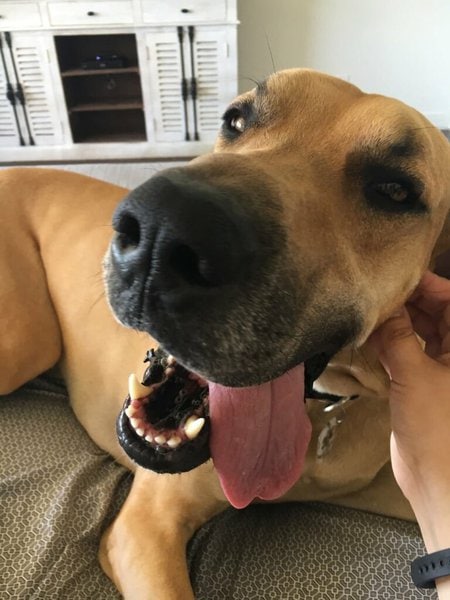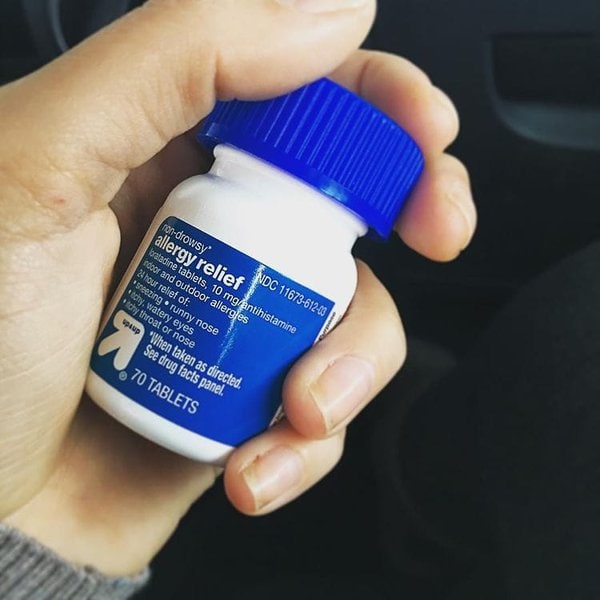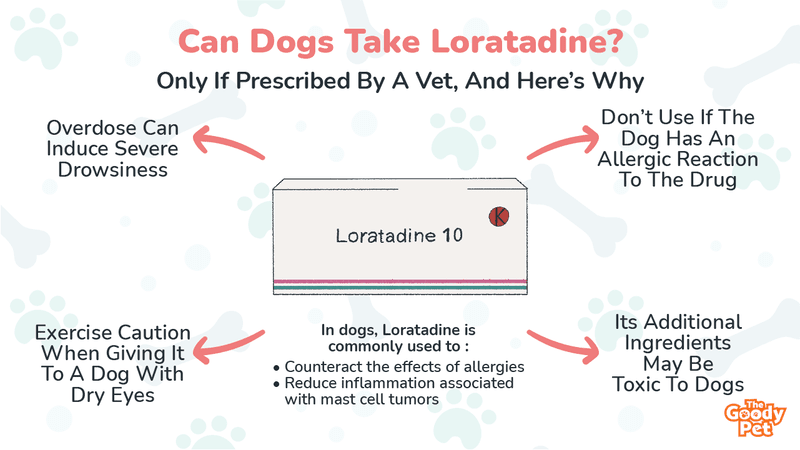Antihistamines can be of immense benefit in treating allergic reactions in dogs, and one of these drugs that is helpful in treating canine allergic reactions is Loratadine. So, is it a good idea for dogs to take Loratadine?
Yes, Loratadine is safe for use in dogs, and this medication has been shown to be effective at curbing different symptoms of allergic reactions in dogs while also inducing minimal side effects in pooches.
The effectiveness of Loratadine in alleviating symptoms of an allergic reaction in pooches is not in doubt, and this is one drug that should definitely make up the contents of your dog’s medicine cabinet.
Today’s article details the different scenarios in which Loratadine can be an effective treatment for your canine buddy, as well as the little details you need to know before treating your pooch with this drug. However, before we go into all this, let’s see why Loratadine is considered safe for dogs to use.
Can Dogs Take Loratadine?

Yes, dogs can safely take Loratadine, provided a vet is consulted beforehand, and the drug is administered according to the recommended prescription.
Loratadine, which is the main ingredient in the widely known antihistamine, Claritin, is an over-the-counter medication that is commonly used to counter symptoms of allergic reactions in dogs.
Traditional antihistamines are noted for their ability to induce drowsiness in their patients, and what sets Loratadine apart is the fact that this drug doesn’t cause the drowsiness that is associated with first-generation antihistamines like Benadryl.
Additionally, the effects of Loratadine within a pooch’s body typically last longer than what is obtainable with traditional antihistamines.
It is also important to note that while the Food and Drug Administration (FDA) has approved Loratadine for use in humans, this drug hasn’t been certified for dog use. Hence, if you’re to treat your pooch with Loratadine, it is recommended that you do so only with a proper vet prescription.
How Much Loratadine Can A Dog Take?
The amount of Loratadine that a dog can safely use is dependent on several factors, such as the pooch’s age and size.
Loratadine is usually made available in 5 mg (oral disintegrating and chewable) and 10 mg (disintegrating and regular) tablets, 10 mg capsules, and 5 mg oral liquid to make measurement and administration easier.
That said, the determination of how much Loratadine a dog can take is determined by factoring in the pooch’s weight. Vets usually prescribe that a pooch uses between 0.12 and 0.22 mg of Loratadine per pound of the dog’s body weight.
How Long Does It Take For Loratadine To Work On Dogs?
Loratadine is a fast-acting drug, and its effects on pooches itching due to an allergic reaction are typically observed within 1 to 2 hours after administration.
That said, the effects of Loratadine on dogs are short-lived, and this medication usually wears out and stops working 24 hours after use.
What Is Loratadine Used For?

Loratadine is commonly used to counteract the effects of allergies in dogs, as well as reduce inflammation associated with mast cell tumors in pooches.
Loratadine Is Effective Against Dog Allergies
Dogs are allergic to a wide variety of substances, and the immune system of a pooch that has been exposed to these allergens typically facilitates the release of histamines as a defense mechanism against the perceived threat of these allergies.
And while this histamine release is typically done with good intentions, this act usually triggers a series of allergic reactions, with severities ranging from mild to severe, in pooches.
Loratadine is effective in combating the effects of these allergies because it inhibits the activities of these histamines within the pooch’s body, thereby preventing itchiness associated with allergic reactions in dogs.
Loratadine Helps Treat Inflammation From Mast Cell Tumors
Another health condition that Loratadine treats effectively is skin inflammation in dogs, which occurs due to the presence of mast cell tumors within the pooch’s body.
Mast cell tumors in dogs occur due to the overgrowth of mast cells responsible for defending the canine body from parasites, and they tend to develop on the pooch’s skin and within the dog’s digestive or respiratory systems.
Can Loratadine Be Bad For Dogs?
Administration of Loratadine formulated with additional products can be extremely toxic for dogs, and overdosing on this drug can also induce side effects in dogs.
Side Effects
Loratadine typically doesn’t induce any serious side effects in dogs, but there are occasions when this drug can cause a pooch to feel sleepy.
The observation of more serious side effects due to Loratadine use in dogs shouldn’t be handled with levity, and you should immediately contact your vet if you notice such effects in your pooch.
Also, it has to be said that the occurrence of severe side effects due to Loratadine use in dogs typically occurs when this antihistamine is used in collaboration with other antibiotics and antifungal medication; Hence, you have to be really careful when combining Loratadine with other medications for your dog.
Loratadine usage has also been linked with the reduction of tear production in humans; Hence, dog owners should be careful when using this drug on pooches with a medical history of dry eyes.
Overdosing
Dogs can handle slight Loratadine overdoses, but excessive consumption of this medication can induce severe drowsiness and other abnormal side effects in a pooch.
Consequently, if you suspect that your pooch has consumed more Loratadine than normal, get in touch with your vet or an animal poison control center for further instructions.

What You Should Know About Treating Your Dog With Loratadine
When using Loratadine, to ensure your canine buddy’s safety, there are some things you need to know about administering this drug to pooches, and some of these things include:
- Loratadine shouldn’t be used in dogs with a past history of allergic reactions to this drug.
- If your canine buddy has an appointment for allergy testing, it’s best that you stay away from Loratadine for the time being. Loratadine blocks the effects of histamines within a pooch’s body, and this can significantly alter the results of the tests.
- Loratadine should be moderately administered to working dogs, as this drug may induce drowsiness and reduce the pooch’s effectiveness.
- Dogs suffering from underlying gastrointestinal issues and liver and kidney problems should also be closely monitored for side effects when treated with Loratadine.
- Only treat your dog with products that contain just Loratadine as an active ingredient. The presence of additional ingredients, such as painkillers and sweeteners like xylitol in products containing Loratadine, can be highly toxic to a dog.





